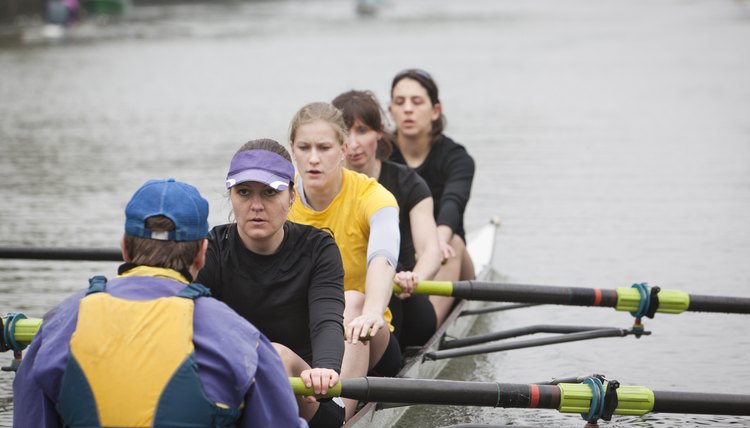Coxswain Requirements

An essential non-rowing position on the crew team, the coxswain sits at the back of the boat and guides the rowers through the race. Working with verbal commands, it is the coxswain's job to motivate the rowers, steer the boat and execute the team's race plan. Precious seconds often determine a race in crew; the coxswain is key to keeping the team operating with the utmost speed and precision.
Height and Weight
Coxswain's tend to be slight in size, which helps to minimize the drag on the boat. Some men's college teams will even have a female coxswain to help keep the body weight on the boat down. US Rowing, the governing body of rowing in the United States, does require female coxswain's to weigh at least 110 pounds for all rowing events. Men must weigh at least 125 for college rowing events and a minimal of 120 pounds for all other rowing events.
Guiding the Team
Most coxswains will train with their team during the season, but they will often take on a coaching role for practices since the athletic requirements differ for their role. To keep their weight down, coxswain's also need to avoid packing on too much muscle. Instead of fully engaging in the team's workout, the coxswain may lead the crew through dry land drills such as calisthenics and running exercises. The idea is to build a bond with the team early so that they are all working as one in the water.
The Cox Box
The coxswain will also run the cox box on the boat. This is a small device that looks like an over-sized stopwatch with two speakers connected to it that the coxswain uses to measure stroke rate and speed of the rowers. It also serves as an amplification device so that all of the rowers can hear commands. A typical eight-man boat is more than 30 feet long and often the person sitting farthest away from the coxswain can't hear the commands.
The Commands
The coxswain's job is to give instructions to all of the rowers in the boat. Clubs and teams may use different words for commands, but all instructions generally have the same meaning. For example, the coxswain may tell the rowers to "push off," which means to use their arms and then their oars to leave the dock. The coxswain then may give a command such as "oars away" or "ready," which means to get prepared to start rowing. Once in a race, a cox may yell out commands for specific members based on their position on the boat, which normally are numerical. These commands could be for things such as to row harder, get in time or to pull back on the oars.
Steering the Boat
Most racing shells have a small tiller that the coxswain uses to help guide the boat. These will alter the path, but it is mainly the power of the rowers that is guiding the boat. If one side is rowing stronger than the other, the coxswain will give orders to even out strokes to keep the boat straight.The coxswain needs to talk to a coach or race official beforehand to know about any possible problems on the course such as swift currents and areas of high wind.
Ending a Race
Once a team finishes the crossing line, it is the coxswain's job to get the team back to shore. They will have to watch for cues from the race officials before they turn their boat to head back to the starting spot or whether they can coast to shore somewhere else to get on dry land. The coxswain is the first person to leave the boat once the team gets to shore; once on land she will give orders for the rest of the team to exit and bring the boat out of the water.
